Ultimate Wind and Wave Insights for Extreme Sports
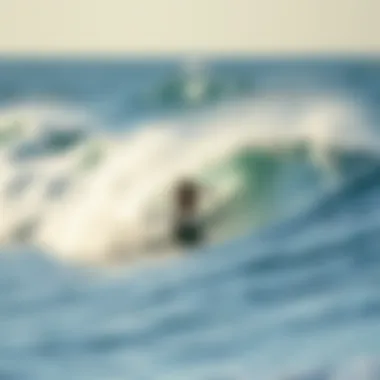
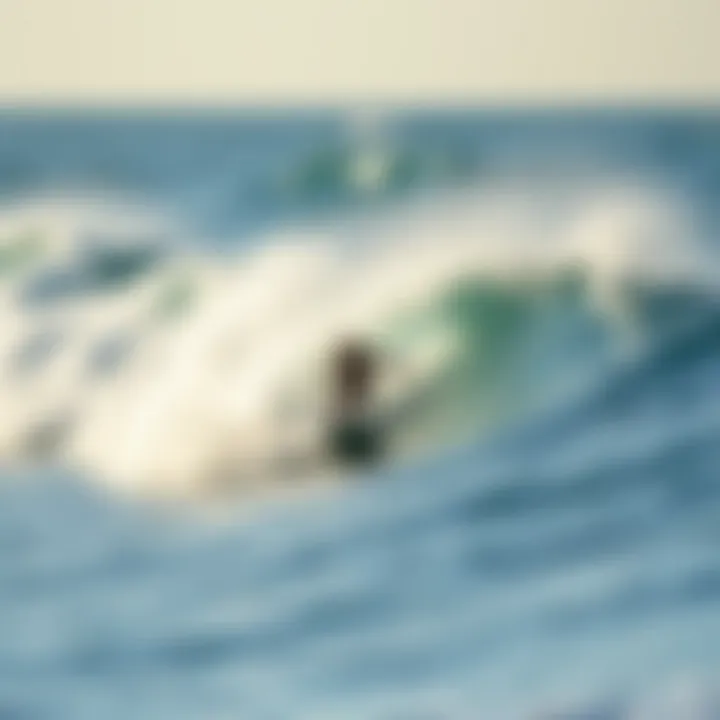
Intro
Engaging in extreme water sports like surfing and kiteboarding requires more than just a thirst for adventure; it demands a deep understanding of the elements, specifically wind and wave conditions. These two factors play a pivotal role in determining not only the quality of your ride but also your safety. As enthusiasts know, conditions can change in the blink of an eye, turning a calm day at the beach into a stormy struggle against the elements.
The intricacies of wind patterns and wave dynamics are not merely academic; they're practical matters that can dictate the success of your session. Whether you are a novice trying to catch your first wave or an experienced rider seeking the perfect spot to carve out your next line, having your ear to the ground about local conditions is indispensable.
This report aims to provide a treasure trove of insights that will arm you with the necessary knowledge to navigate these watery escapades with both confidence and proficiency. As you read on, expect to dive deep into critical aspects like how to interpret forecasts accurately, which locations to choose based on current conditions, and practical tips that can enhance your skills while minimizing risks. The more you know about wind and wave conditions, the better your experience will be out there.
Thus, for those thrill-seekers eager to ride the waves and harness the winds, this guide is your roadmap. Your adventure is just a few breaths away.
Understanding Wind and Wave Dynamics
Getting a grip on wind and wave dynamics is essential for anyone looking to dive into extreme water sports. Winds and waves don't just shape the ocean's surface; they significantly dictate the overall experience of activities like surfing, kiteboarding, and sailing. Understanding this interplay helps enthusiasts make informed choices about when and where to engage in these thrilling pursuits. So, let’s break down what wind and waves really bring to the table.
The Science of Waves
Wave formation
Waves start when wind blows across the surface of the ocean, sending energy through the water. This formation process isn’t just a matter of physics but also artistry. For example, the characteristic rolling of a wave—its crest and trough—comes from the energy transferred by the wind. The size and strength of these waves are influenced heavily by the wind's speed and duration. Typically, the stronger the wind, the larger the waves it can form. Understanding this process helps extreme sports enthusiasts not only enjoy their activities but also stay safe by knowing what conditions to expect.
The unique aspect of wave formation is the variations generated by different currents and winds. Some waves can be gentle and rolling, while others might be dauntingly steep, known as steep waves. These contrast widely in potential hazards between them.
Wave height measurement
Measuring wave height is crucial in understanding what you might face on the water. This measurement gives you insight into the types of waves you’ll be dealing with, affecting everything from your surfing technique to kiteboarding strategies. Typically, wave height is measured from the trough of the wave to its peak. In practical terms, using visual guides or buoys fitted with instruments is popular for gauging these heights accurately.
This measurement matters significantly for planning your water sports. Higher waves can often lead to challenging conditions, demanding experience and skill. However, smaller waves could mean a relaxing day out in the water or a good training opportunity for beginners.
Frequency and period of waves
The frequency, or how often waves hit a given point, and the period, how long it takes for one wave to pass a fixed point, are key to strategizing when to ride the waves. For surfers and kitesurfers, understanding these metrics can determine the rhythm of the surf session. A balanced session feels just right when matched to wave frequency.
Knowing the wave period helps identify whether you'll be dealing with quick succession of waves or longer breaks in between. The former often leads to thrill and adrenaline, while the latter can allow for a more measured approach. This becomes even more relevant in competitions where timing is everything.
Impact of Wind on Waves
Wind speed effects
Wind speed affects everything. When the wind is whipping at high speeds, it tends to create steeper and choppier waves, which can be perfect for experienced surfers looking for that extra thrill. On the contrary, lighter winds generally lead to smoother, more mellow waves, ideal for a leisurely session on the water.
Knowledge of wind speed also allows wave riders to choose their adventure based on their skill level. Out here, too much wind can be a double-edged sword. While it can mean bigger waves, it can also lead to dangerous conditions if not navigated carefully.
Directional influence
The direction from which the wind blows can greatly affect the type of waves created. For instance, winds blowing directly onshore can create messier conditions, while offshore winds can help clean and shape waves, making them more favorable for surfing.
Recognizing wind direction equips enthusiasts with key insights into whether conditions will be favorable for their sport. Riders can take advantage of certain wind angles to optimize their performance on the water, playing a critical role in their overall experience.
Fetch and wave development
Fetch, or the distance the wind travels across open water, is another pivotal factor. A longer fetch can generate larger, better-formed waves since the wind has more time to impart energy into the water. In regions with limited fetch, waves can come across as choppy and disorganized, which might not be ideal for certain water sports.
The importance of fetch lies in its ability to predict how large waves can become based on wind duration and distance. A clear understanding of fetch can guide sports enthusiasts to select the right time and place for their adventures, improving their safety and enjoyment.
"Weather conditions and ocean dynamics are players in the game, but knowing their strengths and weaknesses gives you the upper hand."
In summary, understanding wind and wave dynamics is not just an intellectual exercise. It equips extreme sports lovers with the knowledge necessary for making intelligent, safe, and enjoyable choices when engaging with the elements. By dissecting aspects such as wave formations, height measurement, and the impact of wind, adventurers gain valuable insights that elevate their experiences in water sports. Navigating the wild waters requires respect for nature’s magnitudes, but with the right knowledge, the adventure becomes truly exhilarating.
Types of Waves Encountered
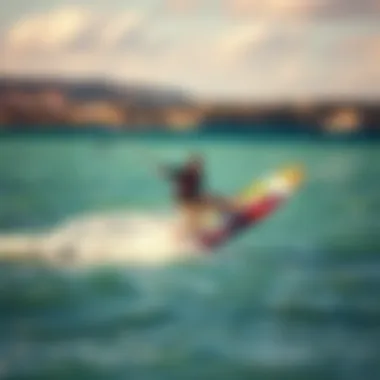

When it comes to extreme sports, recognizing the types of waves you might face is crucial. This knowledge not only informs your choices but also enhances safety and performance. The distinction between swells and local wind waves plays a fundamental role in how an experience might unfold on the water.
Swells versus Local Wind Waves
Characteristics of swells
Swells are often the darlings of surfers and kiteboarders. They originate from distant storms, traveling across vast expanses of water. Unlike their local counterparts, these waves typically offer a steady and smooth ride, making them a desirable option for practitioners. One key characteristic of swells is their long wavelength, which can provide more time and space for maneuvering. Their uniformity can be a game-changer, allowing riders to plan their moves with precision.
However, not all swells are created equally. Depending on the source, the swell may vary in size and power, which can either amplify excitement or present challenges to even the most seasoned athletes.
Understanding local wind waves
In contrast, local wind waves are born from the immediate action of wind on the water. These waves tend to be choppier and shorter in wavelength. While they can pack a punch, they might not offer the same sustained ride that swells do. A key aspect to note is that local wind waves can change rapidly with shifts in wind direction, which adds an element of unpredictability.
For those engaged in extreme sports, mastering how to navigate local wind waves can be the difference between glory and wipeout. They require quick reflexes and adaptability, making them a less predictable but thrilling challenge for enthusiasts.
Differences in surfing conditions
The differences in surfing conditions stemming from swells and local wind waves can greatly affect the dynamics of your sporting experience. Swells generally create more favorable conditions for surfing; they allow for longer rides and smoother transitions. On the other hand, local wind waves can make for a more turbulent experience, which may appeal to thrill-seekers looking for an adrenaline rush.
The take-home message is simple: understanding these differences is invaluable. Choosing to surf or ride in certain conditions depends heavily on the types of waves present. Knowing what you're up against can help you avoid potential dangers, maximize fun, and also enhance your skill level.
Breaking Waves
Just as important as the types of waves encountered are the breaking waves that surfers and extreme watersports enthusiasts often seek out. The act of a wave breaking transforms its characteristics significantly.
Types of breaking waves
Breaking waves occur when the wave energy becomes too much for the water depth. There are several types of breaking waves that one might encounter. The three primary types are spilling, plunging, and surging waves.
Spilling waves, usually seen in shallower waters, tumble gently, which makes them beginner-friendly. Plunging waves, often referred to as "dumping" waves, provide a cleaner but more powerful ride. Surging waves occur in deeper waters and often do not break as dramatically, making them less accessible for riders seeking excitement.
Understanding barrel action
Barrel action refers to the hollow space created when a wave breaks. This phenomenon adds an element of thrill because riding within the barrel is considered a pinnacle achievement for surfers. The unique feature of barrel action is its ability to provide a sheltered, tunnel-like experience as you ride the wave. However, this requires skill and time, since falling within the barrel can result in wipeouts.
A good understanding of barrel action will not only amplify your skills but also your respect for the ocean’s power.
Identifying safe surf zones
Identifying safe surf zones is paramount for any extreme sports enthusiast. Knowing where waves break consistently provides not only an advantage when looking for fun spots but also significantly contributes to safety. This requires understanding the swell direction, the wind effects, and local conditions. Generally, regions with gentler breaks are more forgiving, while areas known for aggressive breaks might be more suited to experienced riders.
Safety should always come first. Outperforming another can be appealing, but it’s wise to know when to call it a day.
"The safety of the surfer is paramount. Knowing the conditions and the wave types can mean the difference between an epic ride and a risky venture."
Forecasting Wind and Wave Conditions
Understanding how to forecast wind and wave conditions cannot be overstated in the realm of extreme sports, especially for those who thrive on adrenaline. It serves as a compass that navigates adventurers through a sea of unpredictable natural elements, ensuring both thrilling experiences and safety on the water. Recognizing and interpreting forecasts can mean the difference between an exhilarating session and a dangerous outing, making this knowledge crucial for enthusiasts.
Utilizing Weather Apps
With the advancement of technology, weather apps have become indispensable tools for extreme sports lovers. They provide real-time information that can help you make informed choices about when and where to go.
Features of reliable apps
A reliable weather app doesn't just throw random data at you. It brings something special to the table: accuracy. Most good apps incorporate advanced algorithms and radar technology to give you detailed insights about wind speed, wave height, and more. Particularly notable features include interactive maps that show you conditions in real-time. For example, Windy.com lets you visualize wind patterns efficiently, which is a tremendous benefit.
However, be cautious of overly simplistic apps that lack depth. Knowing wave and wind conditions is just as crucial as the exercise you're about to have.
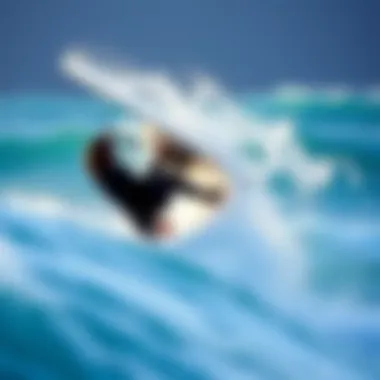
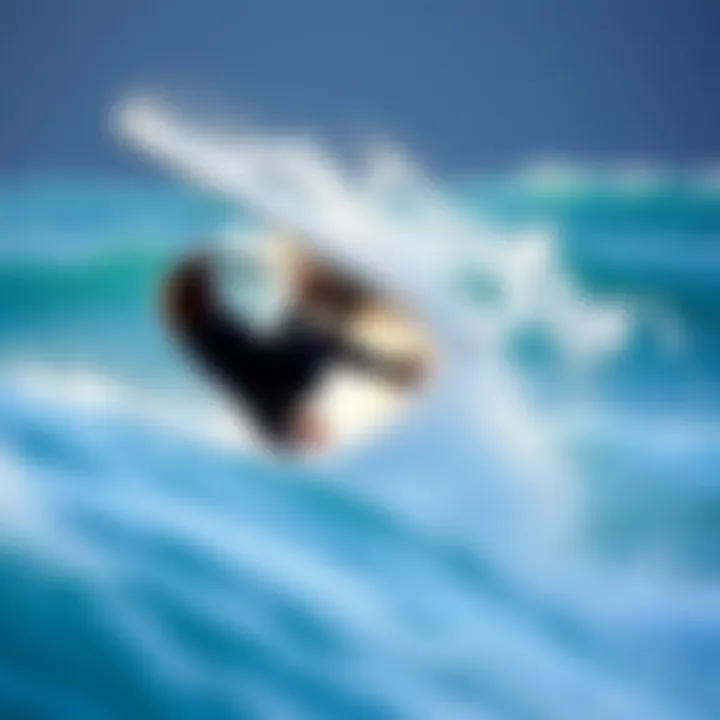
Interpreting data accurately
Interpreting data accurately is the ability to sift through numbers and charts and translate them into practical information. The essence of this skill lies in understanding what wind and wave readings mean for your chosen activity. For example, a sustained wind speed of 20 knots might be perfect for kiteboarding but could make surfing conditions more chaotic.
Having a really good grasp of data interpretation equips you to optimize your sport timing, avoiding surprises that could knock the wind out of your sails—literally. The catch here is that misreading even a small detail can lead to decisive errors in judgment. Thus, thorough practice and comprehension are paramount.
Comparing forecasts across platforms
No single app is entirely foolproof, and sometimes forecasts can differ significantly between platforms. By comparing forecasts across platforms, you're not putting all your eggs in one basket. You get a rounded view that incorporates various meteorological perspectives. Some platforms may excel in wind data while others provide better wave analysis. For example, a comparison between Windguru and Surfline can yield insight that helps you make a more informed choice on a windy day.
Moreover, discrepancies can often point to localized weather phenomena that a single app might miss. Exploring multiple resources enhances your chances of hitting the sweet spot for your next adventure.
Understanding Meteorological Reports
Diving into meteorological reports can seem daunting at first, but this knowledge is a treasure trove that can be incredibly useful. Many enthusiasts often overlook the wealth of information provided in these reports, which can predict conditions well in advance.
Key terminology explained
To make the most of meteorological reports, understanding key terminology is essential. Terms like barometric pressure, isobars, and anemometer readings might sound like an alphabet soup, yet they are vital for grasping what conditions will be like. They help you build a keen sense of potential hazards and opportunities.
For instance, low pressure often leads to turbulent weather—unpredictable from both a surfing and kiteboarding vantage point. By understanding these terms, you put the odds in your favor, enabling you to plan—head and shoulders above those who gloss over this critical information.
Analyzing wind direction and intensity
Wind direction and intensity are not just numbers; they dictate how waves behave, which is crucial in both surfing and kiteboarding. Analyzing these factors allows you to understand whether conditions will favor or hinder your adventure.
For example, a direct onshore wind can flatten waves, making them less suited for a thrilling surf. Conversely, a cross-shore wind can create perfect conditions ideal for kiteboarding. Grasping these nuances can elevate your overall experience, turning a day on the water into an unforgettable one.
Wave forecasts and expected conditions
Understanding wave forecasts brings to light vital elements about expected surf or swell height at certain times. A well-informed assessment ensures safety and optimizes fun. For example, a forecast showing a swell moving in at 6 feet versus 2 feet drastically changes your plans. Not only does it gauge your riding potential, but it also tells you about safety—whether you’ll enjoy a relaxed day or face more challenging surf conditions.
However, keep an eye on how wave forecasts can shift as conditions evolve, especially if you're venturing out for an extended period.
In the world of extreme sports, knowledge is not just power; it’s survival and enjoyment rolled into one.
Knowing how to forecast wind and wave conditions equips extreme sports enthusiasts with a foundational skills set vital for enjoying their passionate pursuits safely.
Choosing Ideal Locations
Selecting the right location for extreme sports isn’t just about riding the waves or catching air with a kite. It’s pivotal for ensuring safety, maximizing enjoyment, and enhancing skill development. The right spot can mak a world of difference—offering ideal wave patterns, wind conditions, and a safe environment. Therefore, understanding how to assess these location criteria is crucial.
Assessing Conditions for Surfing
Evaluating local spots
Evaluating local spots goes beyond simply reading surf reports. It involves examining the surf break characteristics—how the waves reform, break consistency, and suitability for your skill level. A popular choice, like Huntington Beach, showcases a diverse range of conditions; from small, gentle waves perfect for beginners to challenging breaks for the more advanced. The accessibility of amenities, such as restrooms and parking, enhances the overall experience, drawing more enthusiasts to these well-known breaks. Choosing locations with lifeguards present can also be an invaluable factor, adding an extra layer of safety.
Seasonal considerations
The seasonal aspects of a location can greatly influence water conditions. For example, in Hawaii, winter swells can substantially increase wave size, making it ideal for seasoned surfers but potentially dangerous for novices. Understanding peak seasons can help in planning trips, as certain beaches may offer better conditions during specific times of the year. However, this can also lead to crowded beaches, so weighing the benefits against potential overcrowding is necessary.
Accessibility and safety factors
Accessibility isn’t just about how easy it is to get there; it involves understanding the terrain, potential hazards, and available resources like first-aid stations. A spot like Malibu provides stunning waves but requires knowledge of the local laws regarding surf etiquette and safety measures. It’s imperative to know how to enter and exit the water safely, especially in locations known for strong currents. Highlighting local weather patterns—like sudden changes—or nearby marine life can make or break a day on the water.
Other Water Sports Considerations
Kiteboarding versus windsurfing locations


Kiteboarding and windsurfing have entirely different locality needs. Kiteboarding thrives in areas with consistent wind and minimal obstructions, making spots like the Columbia River Gorge ideal. Conversely, windsurfing can be practiced in more varied conditions but often needs specific slotting. It’s essential to know these distinctions as they can determine your experience and readiness for various wind conditions.
Kayaking in windy conditions
When it comes to kayaking, strong winds can pose unique challenges. Planning trips in coastal waters, such as the Bay of Fundy, requires understanding local wind patterns. Opting for sheltered areas can protect kayakers from the brunt of the wind and ensure more control over their craft. Knowing when to stay ashore can save adventurers from capsizing in open waters.
Fishing and sailboating insights
For fishing and sailboating, the wind plays a dual role; it can assist in navigation but also brings risks. When heading out for a fishing trip, evaluating wind forecasts and understanding how to use it to your advantage can make the difference between a successful outing and a disappointing one. Sailboating, for example, depends heavily on wind direction and speed for maneuverability and safety, necessitating significant attention to local weather patterns.
"Choosing the right spot can often be the unsung hero behind a memorable day of extreme sports."
Understanding these considerations not only augments the overall experience but also reinforces safety, allowing thrill-seekers to enjoy their passions to the fullest.
Safety Precautions for Extreme Sports
Engagement in extreme water sports, such as surfing and kiteboarding, carries inherent risks that can’t be ignored. The enjoyment and thrill of these activities should never come at the cost of safety. Understanding and implementing appropriate safety precautions can transform an exhilarating experience into one that’s also secure and responsible. The dynamic interplay of wind and waves demands a heightened awareness of one’s surroundings and conditions, making it paramount for enthusiasts to be adequately prepared.
Gear and Equipment
Importance of proper gear
Having the right gear is a cornerstone of safely enjoying any extreme sport. In the realm of surfing, for instance, a well-fitted wetsuit serves dual purposes: it keeps the body warm in chilly waters and provides buoyancy. This combination plays a critical role in enhancing performance on the waves. That snug fit can mean the difference between gliding smoothly over the water or being caught in a predicament. When gear is tailored for the sport, it not only boosts performance but also instills confidence in the participant, fostering an environment where they can push their limits with assurance.
Assessing your equipment's condition
Regular evaluation of one’s equipment is equally important. A kayak that seems fine at first glance may harbor unseen issues, such as micro-cracks that could lead to leakage during use. This is an element often overlooked by even seasoned practitioners. Performing checks for integrity—such as inspecting the hull’s surface and ensuring that straps are functioning—is critical. This habit not only prolongs the life of the gear but also enhances the experience on the water, contributing to an overall more enjoyable outing.
Upgrading for performance and safety
As technology evolves, so too does the equipment used in extreme sports. Upgrading gear can significantly affect both performance and safety. For example, newer kiteboarding boards may feature materials that are lighter yet more robust. This advancement allows for improved maneuverability and better handling under varying conditions. While upgrading might carry a hefty price tag, the benefits often outweigh the costs in terms of safety and performance enhancement.
Understanding Danger Signs
Recognizing warning flags
Being aware of warning flags can drastically improve safety while participating in extreme water sports. Red flags typically indicate hazardous conditions, like strong currents that may be unsuitable for surfing. When a flag is flying, understanding its meaning is vital for the safety of everyone involved. This keen observation can avert potentially dangerous situations, allowing enthusiasts to make informed choices about when to hit the waves.
Tidal influences and currents
Tides can change dramatically within a short time frame, influencing waves and currents in ways that can be treacherous if unmonitored. For surfers, a strong incoming tide may create favorable conditions, but conversely, one that’s too strong could lead to sweeping them far from the shore. Measuring tidal activity is essential for both navigating safely and optimizing the experience. Thus, understanding local tides should be part and parcel of any pre-surfing checklist.
Emergency response considerations
Despite the best preparations, emergencies may arise. Knowing how to respond is crucial. Making sure that there’s a first aid kit onboard and that it’s easily accessible can make a world of difference. Additionally, having contact information for local emergency services is advisable. In particular, it is beneficial to understand simple rescue techniques, like how to stabilize an injured person in the water until help arrives. Being prepared with this knowledge creates a safer environment for everyone involved in the sport.
Remaining aware and equipped with safety measures is not just prudent; it is essential for truly enjoying extreme water sports without unnecessary risks.
Ending and Final Thoughts
As we wrap up our deep dive into the intricate world of wind and wave dynamics, it's evident how vital this understanding is for those brave enough to seek thrills on the water. Mastering these elements is not just about adrenaline; it's about ensuring safety and optimizing the experience. In a world where conditions can shift as swiftly as the tide, having a firm grasp of the details discussed can make the difference between an exhilarating adventure and a regrettable misstep.
Recap of Key Elements
Throughout this article, we've explored several key components that shape the wind and wave landscape. These aspects are crucial for anyone partaking in extreme sports. Here’s a succinct list of what we've delved into:
- Understanding Wave Dynamics: From formation to breaking types, recognizing the science behind waves can significantly impact the quality of your ride.
- The Role of Wind: Wind's interaction with waves includes speed, direction, and fetch. Knowing how these factors contribute to surf conditions prepares athletes for what's ahead.
- Forecasting Techniques: Utilizing modern tech like weather apps alongside traditional meteorological reports enriches the approach to planning sessions.
- Choosing Locations Wisely: Each water sport has its ideal conditions, and understanding local spots can not only maximize enjoyment but also minimize risk.
- Prioritizing Safety: The gear you choose, recognizing danger signs, and being informed about emergency protocols are all elemental to safe water sports engagement.
This strategic knowledge empowers enthusiasts to elevate their experience and reduce risks associated with unpredictable elements.
The Ongoing Journey in Extreme Sports
The journey in extreme sports is never static; it's a continuous loop of learning and adapting. Each time you hit the water, new conditions unfold, and experience builds. Enthusiasts must remain vigilant, evolving alongside their mastery of waves and winds. This steadfast commitment is what cultivates not just skill, but also deeper respect for nature's powers.
Consider the common phrase, "You never step in the same river twice." This holds true in our context—every session offers different lessons, prompting adventurers to refine techniques, adjust to varying conditions, and continually push boundaries.
Alongside the thrill, there's a robust community that thrives on sharing experiences, navigating local spots, and exchanging tips. Resources like forums on Reddit (https://www.reddit.com/r/watersports>), articles from educational sites like Britannica (https://www.britannica.com>), and real-time data from relevant meteorological sources can be invaluable in shaping your journey. Stay engaged, stay informed, and most importantly, stay passionate.







